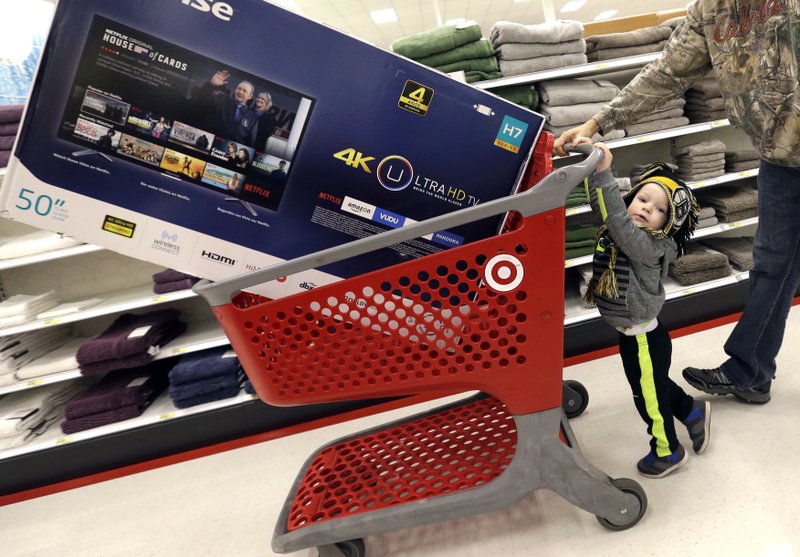WASHINGTON -- The U.S. economy in the third quarter grew at the fastest pace in two years, with a revised report showing stronger consumer spending than first estimated.
The gross domestic product, the country's total output of goods and services, expanded at an annual rate of 3.2 percent in the July-September period, the Commerce Department reported Tuesday. That is up from a previous estimate of 2.9 percent.
The revision was significantly better than the meager gains of 0.8 percent in the first quarter and 1.4 percent in the second quarter when the economy was being held back by a strong dollar and weak business investment.
The 3.2 percent increase was expected to be the best showing for the year. Economists believe that growth has slowed to around 2 percent in the current quarter.
The latest look at GDP, the second of three estimates from the government, showed that consumer spending grew at a 2.8 percent rate in the third quarter, better than the 2.1 percent advance first estimated.
The adjustment reflected data from the Alcohol and Tobacco Tax and Trade Bureau, as well as figures on monthly retail sales, motor vehicle registrations and electricity usage, according to the Commerce Department. Still, consumer spending, which accounts for 70 percent of economic activity, slowed from a gain of 4.3 percent in the second quarter.
"Growth is going to remain heavily reliant on the consumer, but consumers are in very good position to lead that charge," with job gains, wage increases and low debt levels, said Russell Price, senior economist at Ameriprise Financial Inc. in Detroit. "Overall, it's an encouraging sign for the path ahead."
Consumer confidence rose in November to the highest level since July 2007 on increased optimism about the U.S. labor market and economy, according to a report Tuesday from the New York-based Conference Board.
The survey was mostly taken before the Nov. 8 election. Conference Board economist Lynn Franco says that "it appears from the small sample of post-election responses that consumers' optimism was not impacted by the outcome."
The index had fallen in October and was expected to rise this month, but the strength of the rebound took economists by surprise.
"The election result has had a clear positive impact on sentiment," Andrew Hunter, U.S. economist at Capital Economics, wrote in a research note. "It also supports our view that consumer spending will continue to rise at a decent pace over the rest of the year."
The confidence index increased to 107.1 from a revised 100.8 for October.
A little more than 29 percent of the responses, the largest share in three months, said the current economy was in good shape, and more respondents indicated that jobs were plentiful, which bodes well for consumer spending through the Christmas shopping season.
"With the holiday season upon us, a more confident consumer should be welcome news for retailers," Franco said in a statement.
Another area of strength in Tuesday's GDP report was export sales, which grew at a 10.1 percent rate. Although the figure partially reflected a temporary surge in soybean exports, economists are hopeful that exports will show further gains in the months ahead. Earlier in the year, American manufacturers were battered by a strong dollar, which made their goods more expensive on overseas markets.
The 3.2 percent overall GDP gain, the best showing since a 5 percent advance in the third quarter of 2014, is not expected to last. Analysts believe growth will slow to a still-solid 2 percent rate in the current quarter as a temporary boost from businesses restocking their store shelves fades. The swing in inventories added 0.5 percentage point to growth in the third quarter, while the improvement in trade added 0.9 percentage point to growth.
For the year, the economy is expected to grow a modest 1.5 percent, down from 2.6 percent growth in 2015 -- the best performance in the seven years since the recession ended in mid-2009.
While GDP growth is expected to slow, analysts still expect the Federal Reserve to change a key interest rate at its meeting later this month. It would mark the first rate increase since the Fed raised its benchmark rate by a quarter-point a year ago.
During the recent campaign, President-elect Donald Trump decried what he saw as a sluggish economic recovery under Obama, with GDP gains averaging around 2 percent since the end of the recession. Trump said he wanted to set a national goal of reaching 4 percent growth during his administration.
Most economists think that may be overly optimistic given the mass retirement of baby boomers, which would weaken growth in the labor market, and very tepid productivity growth.
Some economists have said they will boost their GDP forecasts if Trump is successful in getting Congress to pass his package of tax cuts and increased spending in such areas as defense and infrastructure projects. But their current estimates put growth at around 2.5 percent over the next two years, an improvement from their current forecast of growth next year of around 2 percent, but well below Trump's 4 percent target.
By major categories, business investment in new plants and equipment edged up at an annual rate of just 0.1 percent in the third quarter. This sector has been held back by steep cutbacks in spending by energy companies responding to the plunge in oil prices. Government spending increased a slight 0.2 percent as a gain at the federal level offset cutbacks at the state and local level.
Information for this article was contributed by Martin Crutsinger and Paul Wiseman of The Associated Press and by Michelle Jamrisko and Patricia Laya of Bloomberg News.
A Section on 11/30/2016

